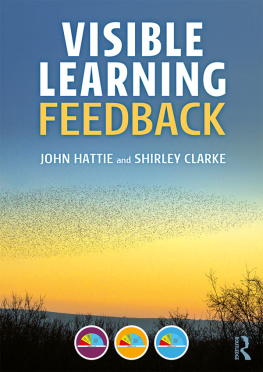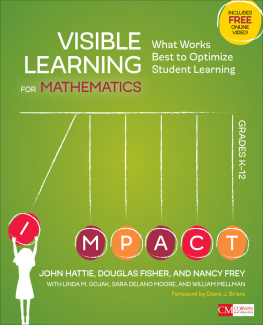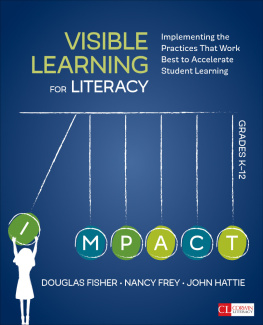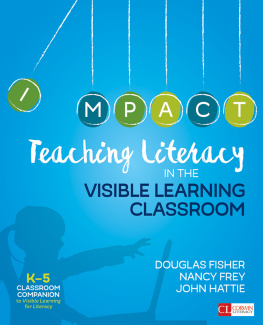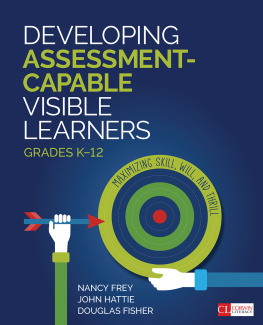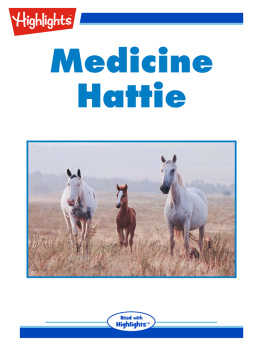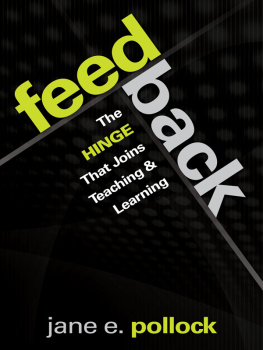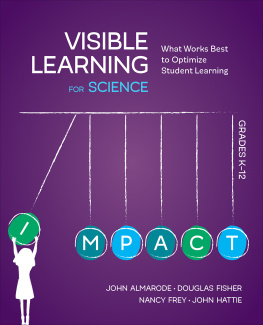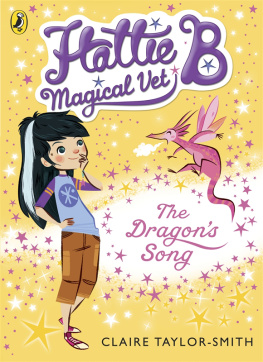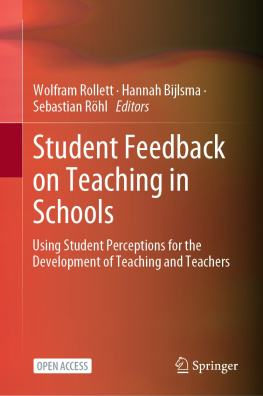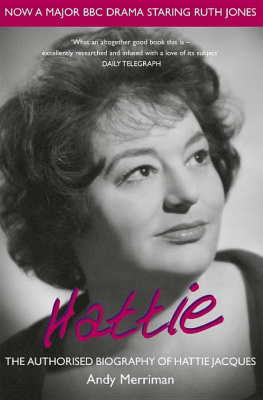John Hattie - Visible Learning: Feedback
Here you can read online John Hattie - Visible Learning: Feedback full text of the book (entire story) in english for free. Download pdf and epub, get meaning, cover and reviews about this ebook. year: 2008, publisher: Taylor and Francis, genre: Politics. Description of the work, (preface) as well as reviews are available. Best literature library LitArk.com created for fans of good reading and offers a wide selection of genres:
Romance novel
Science fiction
Adventure
Detective
Science
History
Home and family
Prose
Art
Politics
Computer
Non-fiction
Religion
Business
Children
Humor
Choose a favorite category and find really read worthwhile books. Enjoy immersion in the world of imagination, feel the emotions of the characters or learn something new for yourself, make an fascinating discovery.
- Book:Visible Learning: Feedback
- Author:
- Publisher:Taylor and Francis
- Genre:
- Year:2008
- Rating:3 / 5
- Favourites:Add to favourites
- Your mark:
- 60
- 1
- 2
- 3
- 4
- 5
Visible Learning: Feedback: summary, description and annotation
We offer to read an annotation, description, summary or preface (depends on what the author of the book "Visible Learning: Feedback" wrote himself). If you haven't found the necessary information about the book — write in the comments, we will try to find it.
John Hattie: author's other books
Who wrote Visible Learning: Feedback? Find out the surname, the name of the author of the book and a list of all author's works by series.
Visible Learning: Feedback — read online for free the complete book (whole text) full work
Below is the text of the book, divided by pages. System saving the place of the last page read, allows you to conveniently read the book "Visible Learning: Feedback" online for free, without having to search again every time where you left off. Put a bookmark, and you can go to the page where you finished reading at any time.
Font size:
Interval:
Bookmark:
First published 2019
by Routledge
2 Park Square, Milton Park, Abingdon, Oxon OX14 4RN
and by Routledge
711 Third Avenue, New York, NY 10017
Routledge is an imprint of the Taylor & Francis Group, an informa business
2019 John Hattie and Shirley Clarke
The right of John Hattie and Shirley Clarke to be identified as authors of this work has been asserted by them in accordance with sections 77 and 78 of the Copyright, Designs and Patents Act 1988.
All rights reserved. No part of this book may be reprinted or reproduced or utilised in any form or by any electronic, mechanical, or other means, now known or hereafter invented, including photocopying and recording, or in any information storage or retrieval system, without permission in writing from the publishers.
Trademark notice: Product or corporate names may be trademarks or registered trademarks, and are used only for identification and explanation without intent to infringe.
Every effort has been made to contact copyright-holders. Please advise the publisher of any errors or omissions, and these will be corrected in subsequent editions.
British Library Cataloguing in Publication Data
A catalogue record for this book is available from the British Library
Library of Congress Cataloging in Publication Data
A catalog record for this book has been requested
ISBN: 978-1-138-59988-8 (hbk)
ISBN: 978-1-138-59989-5 (pbk)
ISBN: 978-0-429-48548-0 (ebk)
Typeset in Bembo and Helvetica Neue
by Apex CoVantage, LLC

John Hattie began his career as a teacher in primary and secondary schools, before moving into academia. His PhD is in measurement and statistics, and he has spent his career using these methods to better address educational questions. He has worked at the Universities of New England, Western Australia, North Carolina, Auckland and now Melbourne.
John is Laureate Professor at the University of Melbourne and co-director of the Science of Learning Research Centre. He is chair of the Australian Institute for Teachers and School Leaders, honorary professor at the University Durham and Auckland. He is past-president of the International Test Commission and associate editor of the British Journal of Educational Psychology and Nature: Science of Learning and serves on the board of 28 journals.
He has supervised 200 thesis students to completion (and is most proud of this) and published and presented over 1,000 papers. His hobby is collecting meta-analyses, aiming to evaluate the relative impact of various interventions. This led to Visible Learning (2009) and now 14 related books, translations into 24 languages, workshops around the world and a mission to more deeply understand the underlying story as to the most important influences.
In September 2001, he met Shirley Clarke in Chester, UK and was so impressed with her skills at translating research into teacher friendly books, he asked to work with her which has led to a best-seller about formative assessment in New Zealand. He has gained from the critiques of his work by Shirley that have sharpened claims and arguments, leading to this book.
Shirley Clarke is an internationally known expert in formative assessment. She works with teams of teachers every year evaluating formative assessment strategies linked with research findings to evolve the practical application of formative assessment. Her many publications and presentations have enabled teachers across the world to have access to research and practical tried and tested strategies. Her work has had a major influence on practice in schools across the UK and beyond.
A former primary teacher in England, she went on to become a mathematics adviser, a test writer and then an academic at the Institute of Education, University College London, during which time she conducted a number of national research projects looking at the impact of testing on teachers and students. She was awarded an honorary doctorate in 2007.
Her publications, with a number of translations, are worldwide best sellers in schools because they combine research with practice in a tried and tested, accessible way. She has added to the support for teachers by capturing video of teachers in action, and now has 140 high quality clips on her website video platform (www.shirleyclarke-education.org). Seeing formative assessment in action by excellent teachers is a powerful way of communicating its impact and use.
In 2001 a New Zealand version of Shirleys book Unlocking Formative Assessment was published, which was the beginning of the liaison with John Hattie, culminating in this book, linking Visible Learning with research findings, practical strategies and examples of excellent practice of feedback.
Co-writing a book 17,000 kilometers apart is fun it heightens the writing. It leads to continual debates and it makes the rare face to face meetings (dinners) all the more fun. This book has had a long gestation we both considered feedback as a critical determiner for enhancing student and teacher learning many eons ago. But the variability was so great. How come about one third of feedback is negative and the same feedback in some situations is powerful but in others detracts? We both explored these notions in the research, in the lab and in the classroom. We developed models and theories, we moved from research to practice and practice back to theory. So many critiqued, questioned, offered ideas and advice. It took 15 years of collaboration before we both felt confident we were ready to put pen to paper.
I thank my colleagues at the various universities I have worked at, my current PhD students, my Visible Learning partners around the world ( Cognition , Corwin; Challenging Learning , Osiris, Bazalt, Onderwijs-Advies) and the many who email with constructive critique. In particular, Luke Mandouit, Cam Brookes and Mark Gan have sharpened these ideas.
I have been with Janet over 30 years and she remains my best critic, provider of feedback and love of my life. Her greatest skills include patience, love, fortitude and good fun and she is the best thing that ever happened to me followed by my family: Joel, Kat, Kyle, Jess, Kieran, Alesha, Edna, Patterson and grandchild Emma.
We thank our Routledge team, especially Bruce Roberts, who has overseen many of the VL books, ensuring they are well edited and presented and he has become a long-time friend.
John Hattie
I thank those colleagues from way back when who gave me opportunities to conduct national research projects at the Institute of Education in London and saw the value of combining research with practice, (a rare thing in the nineties) especially Caroline Gipps, Peter Mortimore, Denis Lawton and Barbara MacGilchrist. Chas Knight, the Hodder editor of all my books so far, deserves special thanks, as his excellence and understanding of what I wanted to achieve played a great part in their accessibility and popularity.
In my ongoing work with many schools and teams of teachers trialling formative assessment strategies, I wish to thank Seamus Gibbons and Gary Wilkie who have worked with me from young teachers to school leaders of excellent schools and along the way have contributed invaluable insights about the real world of formative assessment in action, also Kim Zeidler from the University of East Kentucky who purchased 1000 copies of my latest book for her students, so convinced was she of the power of formative assessment, and invited me to work with teachers there. The subsequent knowledge gained about the nitty gritty of the American school widened my horizons, as well as the two years living in Wisconsin working with educators.
Font size:
Interval:
Bookmark:
Similar books «Visible Learning: Feedback»
Look at similar books to Visible Learning: Feedback. We have selected literature similar in name and meaning in the hope of providing readers with more options to find new, interesting, not yet read works.
Discussion, reviews of the book Visible Learning: Feedback and just readers' own opinions. Leave your comments, write what you think about the work, its meaning or the main characters. Specify what exactly you liked and what you didn't like, and why you think so.

